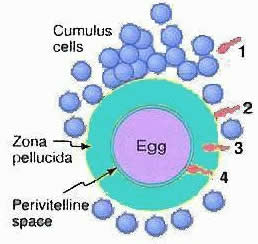These interactions
generally involve lectin-like activities, that is proteins that bding
to carbohydrate moieties in the jelly coat.
After the sperm adheres to the jelly coat, it must pass through it.
This is mediated by enzymes
on the sperm surface.
As the sperm
moves through the jelly coat it is also modified. Within the
jelly coat, and surrounding the egg's plasma membrane is a distinct
layer of extracellular matrix, the vitelline membrane or zona pellucida
(in mammals).
The binding of molecules on the sperm surface to molecules
within the vitelline membrane/zona pellucida triggers the acrosomal
reaction.
The details
of the acrosomal reaction vary beween species, but in the end it
acts to breach the vitelline membrane/zona pellucida and bring the
sperm and egg membranes in close physical contact.
At this point another molecular interaction system leads
to membrane fusion and the delivery of the sperm nucleus into the egg
cytoplasm.
|

